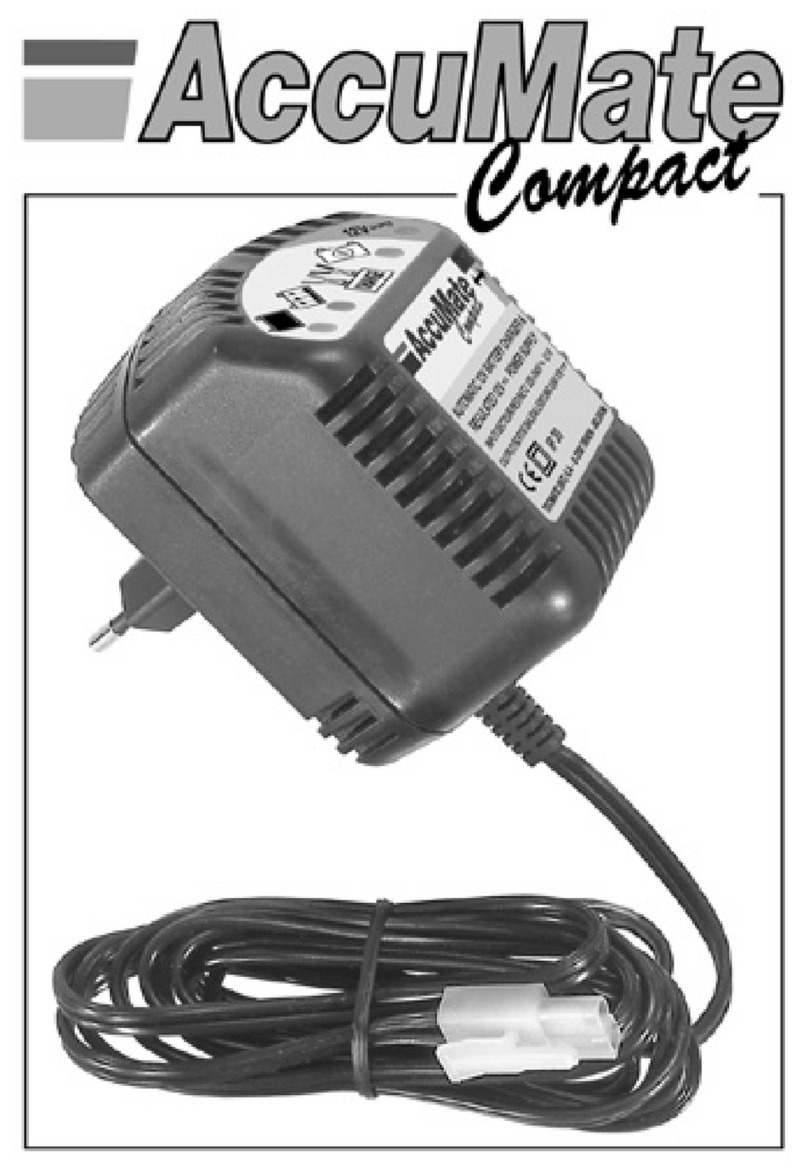
9
caso normal) sea conectado a la masa del vehículo y conectar primero la pinza apropiada al borne no
conectado a la masa y después la otra pinza al chasis del vehículo, pero evitar piezas y lugares dónde car-
burante puede ser presente.
3) Para utilizar el juego de conexión con ojales, véase la sección preliminar sobre.
4) Es importante de asegurar un bueno contacto entre el cargador y los bornes de la batería.
5) Inserir los polos del aparato en la toma de corriente 220-240V~, y si esta ha un interruptor, encenderlo.
Si una cualquier obstrucción impide la inserción completa de los polos, se puede hacer girar el cuerpo del
aparato a través de 90° en relación a sus polos. Retirar el aparato de la toma y localizar la clavija pequeña de
cerradura del movimiento de rotación cerca de los polos del aparato. Utilizar un objeto plano para levantar la
clavija sólo suficientemente para permitir la rotación a través de 90° a la orientación alternativa.
(ATENCIÓN : Levantar con exceso la clavija de cerradura puede resultar en la fractura de la clavija).
6) Véase el panel de indicadores LED sobre. Se encenderá la LED «Encendido». De lo contrario, comprobar la
alimentación CA y los elementos de conexión. Se encenderá la LED VERDE (modo de mantenimiento) a poco
de la conexión si la batería ya es totalmente cargada o... ¡ si sufre sulfatación!).
7) Si la tensión inicial de la batería es superior a 2Volt, el cargador la cargará automáticamente y la man-
tendrá a un nivel de capacidad comparable a él de su carga plena – con tal de que la batería sea en buen
estado. Durante el ciclo de carga (LED AMARILLA), la batería recibe una corriente de nivel máximo, hasta que
alcance una tensión de 14,3V. A este punto, el programa inicia el modo de absorción (tensión de 14,3V igual
y nivel de corriente flotante). NOTA : Si solamente se enciende la LED de alimentación – todas conexiones
estando correctas – significa que la tensión inicial de la batería es por debajo de 2V y que es probablemente
irrecuperable.
8) Cuando la corriente observada por el cargador se hubiera caída debajo de los 300 mA se reducirá auto-
máticamente la tensión de carga hasta los 13,5V. La LED verde comenzará a indicar que la batería está lista.
Mientras que se dejará conectada la batería, el cargador seguirá manteniendo la batería para compensar todo
consumo de corriente, que sea interno o externo a la batería (descarga natural, alimentación de accesorios,
micro corto-circuitos en la red eléctrica del vehículo, etc.).
9) Si, por cualquier razón que sea, la batería necesita una corriente superior a los 300mA, el circuito de carga
volverá automáticamente al modo de absorción (corriente máxima 0,6A) hasta que el consumo de corriente
se hubiera reducido de nuevo, aquello punto el programa volverá al modo de mantenimiento.
10) Es posible que las LED de mantenimiento y de carga indican alternativamente durante un periodo corto
después del primo indicación de la LED verde, especialmente si la batería es bastante vieja o si la batería resta
conectada al alambrado de un vehículo. Si estas indicaciones persistan y la batería resta conectada al
alambrado de un vehículo, desconectarla del alambrado y luego reconectarla al cargador. Si se producen más
tarde de nuevo las mismas indicaciones, la batería es probablemente defectuosa. Si sin embargo la LED verde
indica constantemente más tarde, significa que hay algún defecto en el alambrado mismo.
11) Desconectar la red CA y retirar el aparato de la toma antes de desconectar la batería del cargador.
Sin embargo, el circuito del cargador desactivará instantáneamente la salida de carga en tanto caso.
12) La tabla que se encuentra a continuación indica los tiempos máximos aproximados de carga, desde un
estado de batería totalmente descargada hasta el estado de carga completa. Los tiempos indicados se
aplican en casos de descargas normales (a partir de un estado en aquello la batería no más puede arrancar
el motor). Los períodos indicados no se aplican para casos anormales, por ejemplo si los faros del vehículo se
hablan quedados encendidos durante varios dios, o si la batería fue almacenada sin ser cargada durante
meses en un medio ambiente caliente.




























